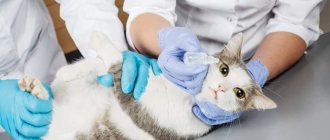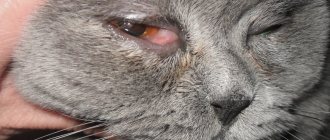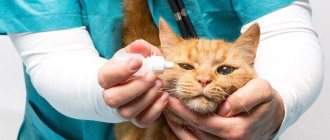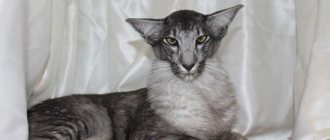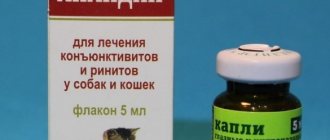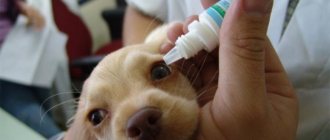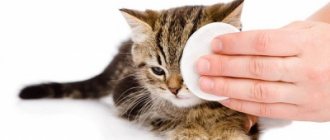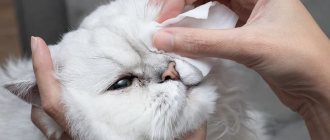6583Pavel
Representatives of the cat family are daily exposed to an increased risk of damage to the mucous membrane of the visual organs, and during play they can become infected with various types of infections, which cause severe irritation. For this reason, it is recommended to regularly instill various medications that can provide protection. But not everyone knows how to put drops in a cat’s eyes, but the effectiveness of the drops depends on knowledge of this procedure. Proper instillation can quickly eliminate irritation and speed up the recovery process.
Why do cats need eye drops?
There are various inflammations specific to the cat family. What exactly are the problems with the sensory organ in domestic cats?
- Redness of the cornea, conjunctiva and lacrimation are evidence of an inflammatory process. The visual analyzer turns red in several cases: conjunctivitis, viral diseases (rinotracheitis), the entry of pathogenic bacteria into the body (chlamydia, mycoplasmosis), vascular keratitis (germination of blood vessels on the surface of the anterior chamber), mechanical damage.
- Swelling of the eyelids is a sign of local or general allergies to chemicals, foods, medications and other allergens.
- Cloudiness of the cornea or lens, loss of shine - such symptoms are evidence of more serious pathologies in the body: keratitis (inflammation of the cornea), glaucoma, intoxication, chemical poisoning, optic nerve atrophy and other dangerous diseases. In this case, immediate veterinary attention is required.
- The release of purulent and mucous exudate is characteristic of the proliferation of pathogenic bacteria in the conjunctival sac. Harmful microorganisms can get there in various ways: during a fight with relatives, with independent damage to the visual organ, due to colds, weakened immunity and general diseases.
- Mechanical injury. If injured by sharp objects (claws, hairpins, knives, wire), the animal may ooze blood, a clear or bloody liquid. In case of such symptoms, you need to contact a veterinarian who can determine the area of the lesion and its causes. In some situations, only microsurgery can save you.
If the animal experiences redness of the visual organ, lacrimation or purulent discharge, then it is necessary to urgently provide first aid (rinsing and instillation) and contact a veterinarian to determine the cause of the disease.
Common diseases
Classification of eye pathologies in cats, symptoms characteristic of each disease:
| Disease | Description and symptoms |
| Conjunctivitis | Occurs due to the entry of a foreign body, trauma to the mucous membrane, exposure to chemicals, and diseases of infectious origin. Characterized by swelling in the eyelid area and a large volume of purulent discharge. The disease can be transmitted from a sick cat to a healthy one. |
| Glaucoma | An increase in pressure in the eyeball can cause clouding of the cornea. The pathology often causes blindness. |
| Keratitis | Inflammation of the cornea is observed with clouding of the mucous membrane of the eyes and increased tearing. |
| bulging eye | Protrusion of an organ occurs due to its damage or the development of a neoplasm. Pathology is fraught with organ loss. |
| Violation of the lacrimation process | Blockage of the tear duct, as well as excessive secretion of fluid. The animal experiences severe discomfort, and the ability to see deteriorates. |
| Cataract | Characterized by clouding of the lens. The eye becomes smoky usually in adult animals and cats suffering from diabetes. |
To prevent the development of any eye disease, a systematic examination of your pet by a veterinarian is required. Without timely treatment, not only a malfunction of the visual system is possible, but also an increased risk of vision loss.
How to put eye drops on a cat at home
Folk remedies are not always dripped into the eyes; most often they are used to wash the organs of vision. This way, the products simultaneously come into contact with the mucous membrane, eliminating signs of pathology, and remove secretions.
Among the folk remedies for cat eyes, the most popular are the following:
- Black tea. It is best to use tea brewed yesterday or at least 10-12 hours ago, but if you don’t have it on hand, you can brew a new one. Only leaf products, loose and not bagged, are suitable for washing; they contain the most useful substances. Do not use tea with flavoring additives - the animal may have allergic reactions. The decoction is made weak.
- Decoctions of medicinal herbs. In first place in terms of polarity are chamomile, calendula, hyssop and St. John's wort. These herbs have long been known for their antibacterial and anti-inflammatory effects. Here you also need a weak decoction, which after infusion should be carefully strained through gauze. If particles of herbs remain in it, they can damage the already irritated mucous membrane of the eye.
- Boiled water. It needs to be cooled to a comfortable temperature (36-37°C) and the cat’s eyes should be washed until completely clean. Water does not have a healing effect, but it removes impurities and suppuration no worse than other means.
How to properly apply flea and tick drops to a cat?
First, let's determine what effect drops from fleas and ticks have on a representative of the cat breed. Depending on the drug and its manufacturer, drops applied to the skin can repel parasites and prevent a bite, or, if an attempt is made to bite, cause death. Which drops are best to choose depends on where the animal lives. If indoors, the owner is unlikely to be happy with live parasites jumping around the house, but it is much easier to remove dead ones by combing or bathing. Among the manufacturers of veterinary preparations on the market, Bars drops have proven themselves well, and they can be found for animals of different ages.
Help from professionals
If, despite all your efforts, the animal does not get better within 7-10 days, but, on the contrary, its condition worsens, then you should immediately contact a veterinary clinic to avoid the development of pneumonia. The same should be done if a cat’s usual runny nose turns purulent. These symptoms indicate the animal’s weak immunity and require complex drug treatment, which can only be prescribed by a doctor. Now you know why your furry pet may have a runny nose, and how to help him get rid of this unpleasant health problem.
Take the advice of experts and be kind to your pet, because now, more than ever, he needs care and your attention.
Having recovered, he will return all the affection to you in full and will gratefully rub against your legs. Health to your purr and sweet cat dreams!
Features of the procedure
There are no fundamental differences in washing the eyes of an adult animal or a kitten: the procedure for performing the procedure is almost identical. The difference lies in small nuances that will help your pet as much as possible and not cause harm.
It all starts with preparing the necessary materials - you will need:
- several clean cotton pads or pieces of gauze;
- clean cloth napkins or towel;
- syringe without a needle (for copious rinsing);
- what you will use to wipe your cat’s eyes is a solution or decoction of herbs.
For aggressive or restless animals, a towel is useful - you can wrap the animal in it - or a retaining bag.
In adults
Adult cats may resist, so you will need an assistant to hold and calm the animal. The cat must be wrapped in a towel or blanket to gently hold it and not harm it during the procedure. Once the animal has been secured, you can begin washing.
First you need to soak the dried crusts, if any. After dipping a cotton pad into the medicinal solution, you need to squeeze the product into the sore eye and wait until the crusts become softer and easier to remove. Gently wipe the disc over the eyelid, being careful not to touch the cornea. Movements should be directed from the ears to the nose, towards the tear duct. Use different pads on different eyes to avoid infection of the healthy eye.
Once the eyes are clean, pour the medicinal solution onto the cornea of the eye using a syringe without a needle - if required by treatment. Normal hygienic cleaning can be left without this step. Remove any remaining solution around the eyelids with a dry cloth or towel. Do not press and try not to touch the eyeball with the tissue so as not to injure it or cause irritation.
How to wash a kitten's eyes
Kittens do not always cope well with washing themselves, as they are accustomed to the mother cat taking care of hygiene. In the first few months, the owner needs to regularly wash the baby’s eyes so that they do not begin to stick together and fester.
The whole manipulation is almost identical to what is done for an adult cat.
However, the procedure should be performed with extreme caution so as not to harm the small pet. You can do without an assistant - you can handle the baby yourself, especially if he is still sleepy
But after eating, you should not carry out the procedure - the kitten may vomit.
If, in addition to rinsing, there is a need to instill medicinal solutions or apply ointments, then precautions should be taken. Unlike adult cats, kittens should not have medicinal solutions put into their eyes immediately after rinsing: you must wait about ten minutes to minimize the risk of irritation.
If you have never owned a cat and do not know how and what to wash a kitten’s eyes with, contact your nearest veterinary clinic or an experienced breeder. You will quickly be shown all the steps of this easy and simple procedure.
Preparing the owner and cat for a medical procedure
Before the procedure, the animal owner must thoroughly wash their hands, disinfect them and wear gloves. There must be a mask on the face.
For a cat you need to prepare everything you need:
- warm boiled water;
- clean soft towel;
- a syringe without a needle or a pipette;
- 2 sterile cotton swabs (for each eye).
The drug must be removed from the cat's field of view. First, taking her in your arms, you need to calm her down, stroke her, and talk to her in a gentle voice. The animal must be securely restrained. A calm cat can be held in your arms or simply pressed lightly against the sofa. A restless one can be wrapped in a towel, leaving only the face visible.
It is good to attract an assistant who will hold the pet or instill medicine.
Home care products
Many people don’t know how to wash a cat’s eyes at home. First aid is a procedure with tea. It should be infused for about 12 hours, without any chemical additives, including sugar.
Also suitable for rinsing are decoctions of various herbs: chamomile, sage, elderberry, linden, string, yarrow, calendula or others that have an anti-inflammatory effect. The concentration of the decoction should be weak: 1 teaspoon per glass of boiling water. The infusion is carefully filtered and cooled to room temperature. Too hot or cold tea will not cure, but will only worsen the disease.
Many breeders are interested in how to wash a cat’s eyes at home. Experts note that boiled or simply distilled water at room temperature is perfect for these purposes, especially for allergic reactions.
Sequence of eye drops for a cat
Indications for eye treatment are pathological processes. For example, this is redness of the mucous membrane of the organ of vision, purulent discharge and gluing of the eyelids.
Before instilling medication into the eyes, you need to gently and carefully wipe the area around the eyes with swabs soaked in warm water to remove pus and other contaminants. Instead of water, you can use any warm tea or chamomile flower decoction.
Procedure:
- Rinse the mucous membranes of one eye first, and then the other with a cleansing solution. Remove wet residue.
- Open the tube with the pharmaceutical preparation.
- Slightly pull the eyelid down and squeeze 2-3 drops of the product into the resulting gap. During the procedure, you need to talk to the animal gently, this will calm him down.
- Massage the eyelid for 5-7 seconds for the best distribution of the medicine. The liquid should not leak onto the wool.
- Repeat the manipulation with the second eye. Do not let go of the animal for 2-3 minutes so that it does not scratch the eyeball.
The pet will feel itching or burning after the procedure. Sometimes the cat may feel severe pain. At this point she will become restless or even aggressive.
What types of eye drops are there for cats and kittens?
Vet pharmacies always have several different drugs in stock. The most popular and effective ones can quickly help with eye inflammation due to simple diseases or injury:
- Ciprovet contains a modern antibiotic. According to the instructions, it is also used to treat kittens. Ciprofloxacin, which is part of it, is able to cope with staphylococcal infections and is effective in the treatment of chlamydia.
- "Diamond Eyes" Contains chlorhexidine and is active against various bacterial flora. Most often used to treat the area around the eyes for diseases and to care for rare breeds of cats. The composition also includes active ingredients such as succinic acid and taurine, which are beneficial for the eyes.
- Levomycetin. Antibiotic, effective against staphylococcal infections, often prescribed to treat conjunctivitis.
- "Bars" (ophthalmic drops). Contains novocaine and furatsilin, has an analgesic and disinfectant effect. Suitable for kittens and adult cats with various bacterial infections.
Diamond eyes
The antibacterial effect inherent in drops called Diamond Eyes is ensured by the inclusion of taurine and chlorhexidine in the structural formula. This drug quickly eliminates inflammatory foci that develop on the conjunctiva and helps cope with degenerative changes in the retina. This drug is often prescribed to a cat as a preventive measure when a predisposition to cataracts is identified.
Every day, our beloved pets spend a lot of time outside, interact with other animals, and therefore have every chance of contracting various infections. One of them is eye inflammation
It is very important to provide first aid in a timely manner without harming your pet, and promptly seek qualified help from a veterinarian in a specialized clinic for proper treatment.
But you shouldn’t self-medicate, since you don’t know exactly what your cat is sick with. Timely and correct treatment plays a huge role, since in advanced stages of the disease this can lead to a deterioration in your pet’s condition or loss of vision.
Redness of the eyeball
- is a consequence of vasodilation as a result of hemorrhages, for example, during injuries. This may indicate diseases such as conjunctivitis, blepharitis, keratitis, and iridocyclitis. And also a similar symptom tells us about an allergy to certain substances that we use.
Various discharge from the eyes (cloudy, bloody, serous, purulent).
Bloody issues
- most often, this is a sign of injury. The degree of damage and treatment should only be prescribed by a veterinarian. Do not try to remove foreign bodies yourself and reach deep into the cat’s eye, as this can seriously harm you. Entrust your animal to a professional.
Purulent and serous discharge
appear due to the proliferation of pathogenic organisms that release harmful waste products, which lead to the formation of discharge. And also, this is a symptom of injuries in which an infection penetrates into the eyeball or a manifestation of colds, but then the symptoms go away quickly and painlessly, but if there is a lot of discharge, you urgently need to see a doctor for help.
Presence of film on the eyes
- it can be bluish or white. This may be the manifestation of inflammation, which occurs as a result of infection.
Severe swelling of the eyelids
- a symptom of allergic reactions.
Excessive lacrimation and frequent scratching of the cat's eyes -
A common cause is a disease such as conjunctivitis. This disease causes inflammation of the connective tissue around the eyes. Caused by a bacterial infection.
Squinting of the eyes due to pain, photophobia -
this means that your cat or kitten is experiencing severe pain and discomfort in the eye area. They cause similar sensations of erosion and ulcers. They manifest themselves as clouding of the cornea, the presence of a cloudy film on the eye. These diseases occur extremely quickly and can lead to serious complications or complete loss of vision.
Cloudiness of the lens -
speaks of the beginning of a serious disease called cataracts. Symptoms of this disease may not be immediately noticed, but subsequently the dog or cat gradually loses its vision. The main sign of the development of cataracts is a change in the color of the pupil.
General weakness and lethargy, loss of appetite
- these general signs should also make you wary and draw closer attention to your beloved pet. There are a lot of symptoms, so to determine the disease and treatment methods for your pet, only a veterinarian can determine
There are a lot of symptoms, so only a veterinarian can determine the disease and treatment methods for your pet.
The order of use of different drugs
If you are using not only tear drops, but also drops to treat other eye diseases or allergies, drip them first. Then wait about five minutes and then add the artificial tear.
You can practice using drops of tear substitutes by dropping them into your eyes, since they do not contain medicinal substances and are only a temporary moisturizer. Therefore, by dripping them into the eyes, you can be sure that allergies or drug overdose will not occur.
Which drops are best to use?
Anandin:
- Therapeutic effect: immunostimulant – anti-inflammatory, antimicrobial, regenerative effect.
- Active ingredient: glucoaminopropylacridone.
- Dosage and frequency of administration: 20 mg per 1 kg of body weight, 2-3 times a day.
Fosprenil:
- Therapeutic effect: antiviral drug.
- Active ingredient: disodium salt of polyprenols phosphate.
- Dosage and frequency of administration: For kittens: single dose - 0.3 cc. cm/kg; daily dose - 0.9-1.2 cubic meters. cm/kg.
- For adult cats: single dose - 0.2 cc. cm/kg, daily dose - 0.6-0.8 cc. cm/kg.
Maxidin:
- Therapeutic effect: immunomodulator
- Active ingredient: IR spectrum bis (pyridine-2,6-dicarboxylate).
- Dosage and frequency of administration: 1-2 drops (in each nostril) 2-3 times a day.
Thymogen:
- Therapeutic effect: immunostimulant.
- Active ingredient: alpha-glutamyl-tryptophan.
- Dosage and frequency of administration: 1-2 drops (in each nostril) 1 time per day.
How to put drops in a cat's eyes
Correct use of medications is a very important factor in treatment. In this case, the process is long and complex. How to properly apply eye drops to a cat?
- Treat the eye and the area around it with a cotton pad or gauze bandage soaked in a medicine or herbal decoction. All crusts, growths, and pustules must first soften, and then they can be easily removed.
- Pull your pet's lower eyelid down slightly after preparing the medicine in your other hand.
- Make sure that the drug does not get on the fur, but in the eye sac.
- The animal will feel discomfort and burning, and will begin to escape from your hands. Don't let him go! Secure your pet in your hands for 3-5 minutes so that the medicine has time to take effect.
- Calm and pet your pet.
- Repeat the procedure several times a day.
Only compliance with the veterinarian's instructions and proper care contribute to a quick recovery. Daily rubbing of the eyes with special preparations or herbal decoctions, as well as cutting off overhanging hair, are measures aimed at maintaining the pet’s excellent vision.
Remember that disease prevention will protect your furry friend from many health problems.
Animal care tips
When treating inflammatory eye diseases, animals are most often prescribed instillation - drip administration of solutions of medicinal agents. When instilling, it is necessary to correctly follow all the rules and recommendations of specialists on the administration of pharmaceuticals.
Only a veterinarian can prescribe medication correctly. A specialist should also monitor and adjust the dynamics of therapy. Uncontrolled or illiterate use of the drug can only worsen the situation. Medicines should not be expired.
Advice! The procedure should be carried out as naturally as possible, otherwise the animal will be scared and not allow the drops to be administered. The effectiveness of the manipulation will be much higher if the animal sits or lies in a calm state.
If the kitten cannot wash itself, then the owner should help it daily using boiled warm water or weak tea leaves.
Inflammation of the eyes is a common symptom in small kittens. A problem detected in time will help to avoid major health problems, and competent assistance will stop the development of the disease. The health of a pet primarily depends on its owner.
Is it possible to put human drops in a cat's eyes?
How to give eye drops to a cat?
Many people have pets that we take care of. But situations happen in life when your pet gets sick and this is very sad. And of all diseases, the most unpleasant and inconvenient disease to treat is eye disease. Most often, such diseases are very difficult and prevent the cat from enjoying life.
The eyes of a cat or cat can get sick for various reasons: bruises, injuries, debris stuck, previous diseases not treated and other reasons. Before starting treatment, all this must be taken into account. Because in order to get rid of and cure an insidious disease, you must first eliminate the cause of its occurrence.
Treating a cat is the same as treating a small capricious child. Your pet will not sit with his eyes open and wait until you finish all the procedures. It is quite natural that he will twitch, resist and run away. Therefore, to put drops in an animal’s eyes, you will have to work hard to catch him or her. And most likely it will not be so easy.
How to give eye drops to a cat? You caught your favorite cat, but at the same time you overturned all the furniture in the house, but this is just the beginning. To instill the drops themselves, you need medicine, a pipette and an assistant who will help hold your pet the way you need.
Be sure to warm the medicine before the procedure; you can simply hold it in your palms for a while, otherwise you yourself will understand what the cat’s reaction to the cold solution will be. Using gentle, gentle and careful movements, you must remove pus from the eyes, this must be done very carefully, and before the procedure itself, in order not to cause additional infection, you need to wash your hands. And if you have large nails, then ask another person to put drops in the animal, otherwise you may damage the cat's eye
Source
Video on how to treat a cat for fleas
Popular questions
If an animal has licked drops of parasites, then you should immediately give it activated carbon or any other sorbent. Signs of severe poisoning include vomiting, salivation and convulsions. Any antiparasitic agents are toxic, so the cat must be taken to a veterinarian for further cleansing of the body.
Flea drops are absorbed into the cat's epidermis within 12-24 hours. Therefore, during this time, you should avoid contact with the animal, that is, do not pet or pick it up, and do not allow other pets to lick it.
No. The simultaneous use of several drugs is strictly prohibited, otherwise intoxication may occur. But after treating a cat with drops, you can, for example, wear a flea collar 1-2 weeks later to prolong the effect.
Treating eye inflammation in cats at home
In most situations, this disease can be treated at home. However, this does not mean that you can select medications on your own.
It is important not only to eliminate the symptoms - redness, swelling and increased lacrimation, but also to get rid of the underlying pathology that led to this problem. A veterinarian must diagnose and prescribe medications.
Veterinary drugs
To quickly and effectively get rid of this disease, you need to eliminate its cause, otherwise all efforts will be in vain. If a pet has an inflamed eye due to an allergy, he is prescribed antihistamines; if this is due to damage to the organ of vision by pathogenic bacteria, antibiotics cannot be avoided. This problem is usually eliminated using drops and ointments. The table provides information about medications used to relieve the inflammatory process in the conjunctiva:
| Drugs | Mode of application | |
| Cleaning products | Diamond eyes | The affected eye is washed several times a day. |
| Ointments | Tetracycline and erythromycin ointments, Levomycetin, Sofradex | A small amount of the product is placed behind the eyelid twice a day. |
| Drops | Dexamethasone, Conjunctivin, Bars, Lacrimin aseptic, Tsiprovet, Barrier | The solution is instilled into the inflamed organ. When determining the dosage and duration of use, you must strictly follow the manufacturer's recommendations or follow the instructions of your veterinarian. |
Folk remedies
If the problem is minor and there are no serious pathologies that provoked its occurrence, you can resort to the help of folk remedies. In other situations, they can be used in combination with drug treatment. However, before using them, they must be agreed with a veterinarian, otherwise the cat can be seriously harmed. This disease can be cured with the help of decoctions of medicinal herbs. Information on the preparation and use of folk remedies for the treatment of conjunctivitis in cats is presented in the table:
| Main ingredients | Preparation | Application |
| Chamomile | 1 tsp. dried herbs pour 200 ml of boiling water. Boil the solution over low heat for 7–10 minutes. After cooling, leave for 1 hour and then strain through several layers of clean gauze. | Instill 2-3 drops into the diseased organ several times a day, apply a compress or rinse the eyes. |
| Dill | Squeeze the juice from fresh washed greens. | Make medicinal lotions. |
| Aloe | Squeeze the juice from a freshly cut, washed, fleshy leaf of the plant. Dilute it with boiled water in a ratio of 1:10. | Instill 2-3 drops of solution into the affected eye several times a day, make a compress or rinse the eyes. |
| Rose hip | Grind 1 tbsp. l. fruits of the bush. Mix the resulting mass with 1 glass of water. Boil the mixture for 10 minutes, then leave it for half an hour, cool and strain. | Use a piece of sterile gauze soaked in the product to remove purulent discharge and mucus. |
| Plantain | Mix 10 g of plant seeds with 200 ml of boiling water. Leave the mixture for 30 minutes, then cool and strain. | Wipe the diseased organ with a cotton pad moistened with medicinal liquid. |
| Almond oil | Not required | Apply 2-3 drops to the mucous membrane of the eye. |
Causes of ear problems in cats
Although there will be many common symptoms, the causes of ear problems in cats are due to different causes. Additionally, ear problems can affect the outer ear, inner ear, or both. These include:
- Earwax buildup/lack of ear cleaning
- Ticks
- Presence of foreign objects
- Bacterial/viral infections
- Rupture of eardrum due to loud noise/trauma
- Chemical irritant entering the ear canal
- Autoimmune diseases
- Tumors
As you can see, most causes of ear problems in cats are relatively treatable. Bacterial and viral infections are usually treatable, but early diagnosis is important. With autoimmune diseases, ear infections are one of many possible complications associated with a weakened immune system. Ear tumors in cats are relatively rare, and you may be wondering if there is an accompanying tumor.
Treatment will depend on the cause. If the otitis media is caused by a foreign object, removing it may be sufficient. However, they may require treatment with antibiotics if there is a secondary infection. Bacterial and viral infections will be treated with drugs specific to the underlying pathogen. For autoimmune diseases, medications can help strengthen their immune system, but more systematic treatment will be required.
Medications can be administered orally, but most ear problems in cats can be treated with ear drops containing the active ingredient.
Indications for use
Veterinarians prescribe “Diamond Eyes” drops to cats for the treatment of ophthalmological ailments of various etiologies and genesis. Used for treatment:
- acute, chronic purulent, allergic, bacterial, catarrhal conjunctivitis;
- blepharitis;
- uveitis;
- keratitis;
- trichiasis;
- cataracts;
- age-related dystrophic changes in the cornea. lens
Eye drops are prescribed to animals with corneal ulcers, to eliminate post-traumatic inflammatory processes, when the eyes are infected with various foreign objects, and hyperemia of the blood vessels of the eyeball (red eye syndrome).
Conjunctivitis in a kitten
When used systematically, the drug eliminates inflammation of the mucous membrane, relieves pain and itching. They can be prescribed to relieve swelling, redness of the eyelids, excessive lacrimation, to relieve allergic reactions that are accompanied by increased formation of exudate, as well as in the postoperative period to prevent the development of eye infectious diseases.
Veterinarians recommend using diamond eyes for everyday hygiene (treatment, washing) of the eyes, removing exudate and dried crusts on the eyelids.
Ophthalmic drops can be used to treat eye diseases in cats and dogs of various age groups and breeds. Suitable for use by pregnant and lactating females.
Benefits of using flea and tick drops
To prevent and remove parasites from cats, specialized collars, sprays, shampoos, injection tablets, powders and drops are used. But if earlier owners preferred collars, now they appreciate the effectiveness of drops.
Among the main advantages of using drops against fleas and ticks are the following:
- Safety for the health of the pet, of course, subject to the instructions on where to apply the drug and in what quantity;
- Quick and strong effect on parasites;
- Ease of use;
- Guaranteed effect from several months to six months;
- The ability to treat your pet immediately against ticks, fleas, and worms with one product.
Please note that drops cannot be used for small kittens. And when choosing drops, be sure to look at the age of the animal and its weight indicated on the packaging.
Tsiprovet
Ciprofloxacin, which is the basic substance of the drug Ciprovet, causes anti-inflammatory, antimicrobial and bactericidal effects. Medicine is prescribed if eye diseases in a cat are caused by the active development of Pseudomonas aeruginosa, mycoplasma, Staphylococcus aureus, and chlamydia. Tsiprovet is used during the preparation of animals for eye surgery, as well as at the rehabilitation stage.
When the initial symptoms of the disease are detected, one drop of the drug is administered three times a day. The course duration is seven days. In complicated cases, when the eyes begin to fester, the dose for adult cats is doubled. For kittens older than seven days, one drop is enough.
How to wash the eyes of a kitten or cat as a preventive measure
It is recommended to monitor the condition of your cat's eyes from an early age. Newborn kittens' eyes open after one to two weeks.
If by the end of the third week the eyes have not opened, you need to wash them very carefully
Adult cats take care of their own hygiene. The daily cat ritual includes washing the face and eyes. But it happens that the cat gets hurt or catches a disease - to prevent complications, periodically examine your pet. If you notice clouding or change in color of the iris, purulent discharge, or fur on the face with traces of tears, then immediately contact your veterinarian. If an injury is detected, do not let the animal rub its eye, as this irritates the mucous membrane. Do not open your pet's eyes by force. Do not use medications containing prednisolone or dexamethasone yourself - you may worsen the situation.
The treating veterinarian will advise what to wash your cat's eyes with as a preventive measure. You can soak a cotton pad with strong tea or saline solution, and then clean the eye with smooth movements. All this is necessary if the cat periodically develops brown crusts - the consequences of poor hygiene and dust getting on the cornea. This is not dangerous if the accumulations are removed from the tear corners in time.
Do not forget to vaccinate your animal once a year, without losing track of the schedule. If you have an elderly or frail pet, take it to the veterinarian regularly.
In the case when simple medications do not help and your pet’s eyes continue to fester, become swollen and stick together, it is necessary to take the animal to the veterinarian. The doctor will make an accurate diagnosis and prescribe age- and breed-appropriate treatment.
The article is of a recommendatory nature. Consult your veterinarian!
Symptoms of ear problems in cats
As we said above, ear disease can be very annoying for a cat. This is one of the most obvious problems, even if the reasons can be very different. If your cat has any of the following symptoms, you should take her to the vet, as she may need to be prescribed ear medications:
© shutterstock
- Ears are red and inflamed (otitis media)
- Ears are warm to the touch
- Excessive earwax accumulation
- Oozing pus or foul odor
- Head tilt
- Repeatedly scratching ears
- Black spots in and around the ears
Although it may be obvious that a problem exists, we need to take the cat to the vet to properly diagnose the problem. Many problems require the prescription of special ear drops.
